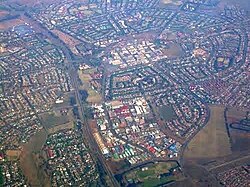Vanderbijlpark | |
|---|---|
 Vanderbijlpark from the air | |
| Coordinates: 26°41′57″S 27°50′8″E / 26.69917°S 27.83556°E | |
| Country | South Africa |
| Province | Gauteng |
| District | Sedibeng |
| Municipality | Emfuleni |
| Area | |
• Total | 177.84 km2 (68.66 sq mi) |
| Elevation | 1,500 m (4,900 ft) |
| Population (2011)[1] | |
• Total | 95,840 |
| • Density | 540/km2 (1,400/sq mi) |
| Racial makeup (2011) | |
| • Black African | 42.5% |
| • Coloured | 1.3% |
| • Indian/Asian | 0.9% |
| • White | 54.4% |
| • Other | 0.9% |
| First languages (2011) | |
| • Afrikaans | 51.0% |
| • Sotho | 19.9% |
| • English | 10.0% |
| • Zulu | 4.9% |
| • Other | 14.2% |
| Time zone | UTC+2 (SAST) |
| Postal code (street) | 1911 |
| PO box | 1900 |
| Area code | 016 |
Vanderbijlpark is an industrial city with approximately 95,000 inhabitants, situated on the Vaal River in the south of Gauteng province, South Africa. The city is named after Hendrik van der Bijl, an electrical engineer and industrialist.
Vanderbijlpark is home to Vanderbijlpark Steel, previously part of the South African Iron and Steel Corporation (ISCOR), which subsequently became a subsidiary of the global company ArcelorMittal. With neighbouring cities Vereeniging and Sasolburg, it forms the Vaal Triangle, historically a major industrial region of South Africa. It is situated in the local municipality of Emfuleni and district municipality of Sedibeng.
The peri-urban black townships Boipatong, Muvango, Bophelong, Sebokeng, Evaton, Tshepiso and Sharpeville are close to the city.
- ^ a b c d "Main Place Vanderbijlpark". Census 2011.


